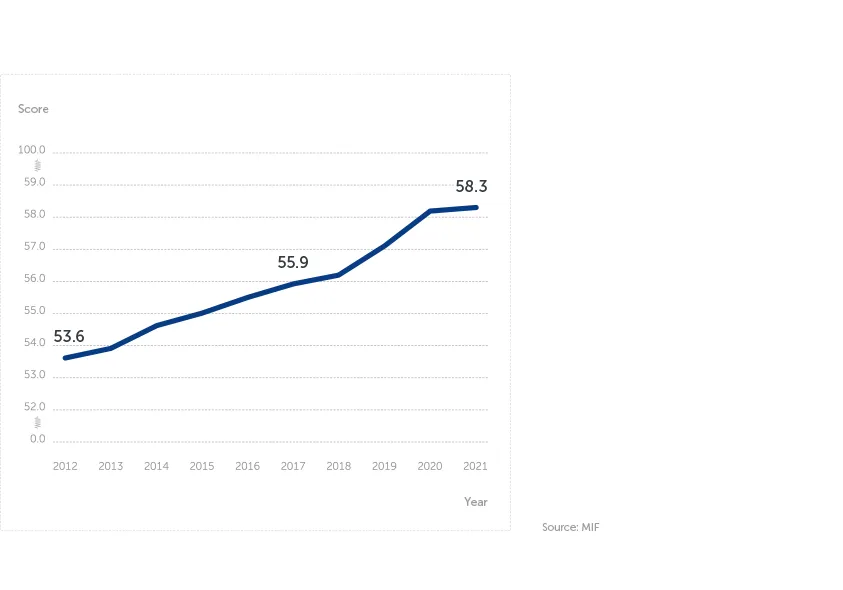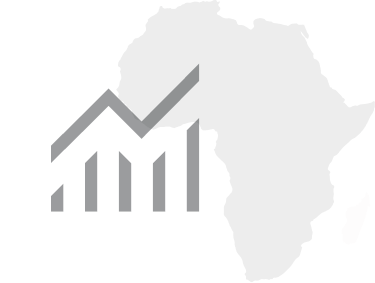COVID-19 laid bare Africa’s weak health capacities
27 February, 2023
The IIAG Health sub-category mainly measures traditional health-related Millennium Development Goals (MDG targets such as child and maternal health and communicable diseases. It already incorporates health targets from the Sustainable Development Goal (SDG) 3 (‘Good health and well-being’) such as healthcare access (equality and affordability) and non-communicable diseases. However, the IIAG is still unable to include indicators assessing health structure/capacities due to insufficient data coverage for African countries.
Health performance in the 2022 IIAG
With a score of 58.3 (out of 100.0), Health is the third highest scoring out of the IIAG’s 16 sub-categories in 2021. Health has also been the third most improved sub-category over the decade 2012-2021, with 48 (out of 54) African countries following a positive trajectory in that period. Since 2012, the positive trend in Health has been mostly driven by progress in indicators related to the MDGs.
- Four out of six Health indicators have experienced improvement: Child & Maternal Health (+8.4), Control of Communicable Diseases (+8.2), Compliance with International Health Regulations (IHR) (+8.1), as well as Access to Water & Sanitation (+5.5).
- The remaining two indicators have followed a negative trajectory: Control of Non-Communicable Diseases (-1.4) and Access to Healthcare (-0.6).
Africa: IIAG Health Scores (2012-2021)

COVID-19 has exacerbated concerning pre-existing trends across whole IIAG
Between 2019 and 2021, COVID-19 has exacerbated concerning pre-existing trends across the whole IIAG. As a result, Africa’s Overall Governance score has flatlined (at 48.9 out of 100.0). The pandemic impact has worsened the security situation even further, as well as accelerated the erosion of democracy on the continent – with the declines in the IIAG categories Security & Rule of Law and Participation Rights & Inclusion accelerating since 2019.
Progress has also halted in IIAG sub-categories such as Education and Sustainable Environment since 2019. It is important to note, however, that progress in Foundations for Economic Opportunity has taken place at a faster pace between 2019 and 2021. Despite the seismic impact of COVID-19 on Africa’s economies, this is the only IIAG category to improve performance since 2019.
Long-standing gaps in Africa’s health capacities brought to the fore by COVID-19
As highlighted by MIF’s reports COVID-19 in Africa one year on: Impact and Prospects (2020) and COVID-19 in Africa: A challenging road to recovery (2021). The COVID-19 pandemic has laid bare the continent’s lack of capacity when dealing with heightened and complex health challenges that require highly qualified staff and specialised equipment, such as critical care facilities and ventilators. According to the World Health Organization (WHO), fewer than 2,000 working ventilators were available to serve hundreds of millions of Africans in public hospitals across 41 African countries in 2020. To worsen the crisis there were 10 African countries that had no ventilators at all.
Out of all African Nations that committed to achieving Universal Health Coverage (UHC), only Algeria, Botswana, Burkina Faso, Gabon, Mauritius, Namibia, Rwanda, Seychelles, Tunisia and Zambia countries actually provided free and universal healthcare in 2021.
In the sub-Saharan region, in 2018 only 1.9% of its Gross Domestic Product was spent on public health, in comparison with other regions this is the 2nd smallest share in the world.
This shows that besides the lack of resources, the longstanding crisis in Africa’s health capacities results from insufficient domestic financial commitment, inadequate infrastructure and the pervasive problem of ‘brain-drain’.
Hospital bed density (per 1,000 people)
Only 11 African countries have at least one year’s worth of data over the ten-year IIAG time series (2012-2021). Using the latest data year available over that period, more than half (6) of those countries have one or fewer hospital beds available per 1,000 people.
Nurses and midwives
At a global level in 2018, sub-Saharan Africa has the lowest density of nurses and midwives per 1,000 people (1.0).
Physicians
At a global level in 2017, sub-Saharan Africa has the lowest density of physicians per 1,000 people (0.2).


